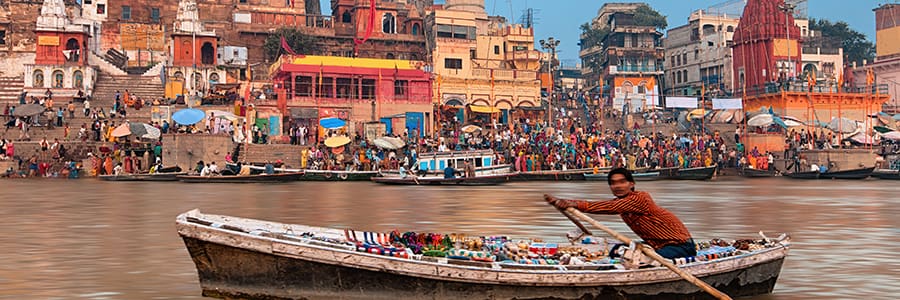
About The Ganges River
Ganga is the Hindu goddess who personifies the Ganges.
Rising in the Himalayas and emptying into the Bay of Bengal, the Ganges drains one-fourth of the territory of India, its basin supporting hundreds of millions of people. For most of its 1,560-mile course it is a slow and sluggish stream, flowing through the heartland of the region known as Hindustan, cradle of civilizations for millennia.
Nearly all tours supplied by Western operators include a Golden Triangle land tour, visiting the grand monuments of Delhi, Agra, and Jaipur, but it is the river cruise along the Ganges that allows travelers to experience the human side of India. The banks of the Mother Ganges have been nurturing life for time immemorial, and only aboard a river cruise ship can you truly slip into the pace of life on the water, to get up close and personal to take the pulse of everyday life and visit villages where craftspeople specialize in traditional arts like brass work and colorful textiles.
Tours of the Kolkata portion of the Lower Ganges offered by American and British tour operators generally run from October to March, with February being one of the best months to go. Most companies charter nearly identical 56-passenger ships called the Ganges Voyager and Ganges Voyager II.
Ganges River Stats
Length: 1,569 miles
Depth: Average 52 feet, maximum 108 feet
Source: Glaciers and melting show from the Himalayas
Mouth: The Ganges Delta into the Bay of Bengal, Bangladesh
Locks: 0
Countries: India | Bangladesh
Learn more about the Ganges River of Asia
The Ganges River, often referred to simply as the Ganga, holds a revered and iconic status in the heart of India and beyond. Stretching over 2,525 kilometers (1,569 miles), it ranks among the longest rivers in the world and is not just a geographical entity but a spiritual, cultural, and ecological lifeline for millions of people. Its significance extends far beyond its physical dimensions, making it a subject of fascination and admiration worldwide.
Geography and Flow
The Ganges originates from the Gangotri Glacier in the Indian state of Uttarakhand, high in the Himalayas, where it’s known as the Bhagirathi River. As it flows down through the rugged terrain, it merges with the Alaknanda River at Devprayag, becoming the Ganges. The river continues its journey through the Indian plains, passing through several major cities, including Haridwar, Kanpur, Allahabad (Prayagraj), Varanasi, and Patna, before emptying into the Bay of Bengal in the Sundarbans Delta.
Spiritual and Cultural Significance
The Ganges is more than just a river; it is a spiritual symbol and a source of faith for millions of Hindus. It is believed to be a goddess, Ganga Mata, who descends from the heavens to cleanse the souls of the devout and grant salvation to the departed. Bathing in its waters is considered an act of purification, and the ashes of the deceased are often immersed in the river to ensure a smooth journey to the afterlife. The cities along the Ganges are steeped in history and culture. Varanasi, also known as Kashi, is one of the oldest continuously inhabited cities in the world and holds immense religious significance for Hindus. It is believed that Lord Shiva himself resides here, making it a major pilgrimage site. The Ganges has inspired poets, philosophers, and artists for centuries. It has been the backdrop for countless stories, songs, and artworks, making it a cultural icon that transcends borders and languages.
Environmental Importance
The Ganges is not just a spiritual and cultural icon; it is also an ecological treasure. The river and its floodplains support a diverse range of flora and fauna, including the endangered Ganges river dolphin, gharial crocodile, and various species of turtles and fish. The fertile plains around the Ganges are a major agricultural region, providing food for millions of people. However, the Ganges faces significant environmental challenges. Pollution from industrial and domestic sources, as well as agricultural runoff, has severely degraded water quality. Efforts to clean the river have been ongoing for decades, with the Indian government launching the ambitious “Namami Gange” (Clean Ganga) program to address pollution and promote sustainable river management.
Economic Significance
The Ganges also plays a crucial role in the economy of India. The fertile soil in its basin supports extensive agriculture, and the river serves as a vital transportation route for goods and people. The Ganges Delta in Bangladesh, where the river meets the Bay of Bengal, is one of the most productive and densely populated regions in the world, contributing significantly to the economies of both India and Bangladesh.
Challenges and Conservation
Despite its immense cultural and environmental importance, the Ganges faces numerous challenges. Pollution, over-extraction of water, deforestation in the catchment area, and the effects of climate change, including erratic rainfall and glacial melt, pose serious threats to the river’s health. Efforts to conserve the Ganges are ongoing, with initiatives aimed at reducing pollution, restoring ecosystems, and raising awareness about the river’s importance. International organizations, governments, and NGOs are collaborating to tackle these issues and ensure the long-term sustainability of the Ganges.
